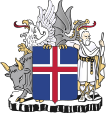
Parliamentary elections were held in Montenegro on 20 October 2002. The result was a victory for the For a European Montenegro alliance formed by the Democratic Party of Socialists (DPS) and the Social Democratic Party (SDP), which won 39 of the 75 seats. It was the last parliamentary election held in Montenegro prior to independence referendum in 2006.
Parliamentary elections were held in Iceland on 9 June 1963. The Independence Party won 16 of the 40 seats in the Lower House of the Althing. Bjarni Benediktsson became Prime Minister after the elections.
Parliamentary elections were held in Iceland on 23 April 1983. The Independence Party remained the largest party in the Lower House of the Althing, winning 15 of the 40 seats.
Parliamentary elections were held in Iceland on 8 April 1995. They were the first elections after the Althing became a unicameral parliament in 1991. The Independence Party remained the largest party, winning 25 of the 63 seats. The coalition government of the Independence Party and Progressive Party remained in office, with Davíð Oddsson continuing as Prime Minister.
Parliamentary elections were held in Iceland on 8 May 1999. The Independence Party remained the largest party in the Althing, winning 26 of the 63 seats. The coalition government of the Independence Party and Progressive Party remained in office, with Davíð Oddsson continuing as Prime Minister.
The Russian Party in Estonia was a minor centre-left political party in Estonia.
Parliamentary elections were held in Iceland on 20 April 1991. The Independence Party remained the largest party in the Lower House of the Althing, winning 17 of the 42 seats.
Early parliamentary elections were held in Iceland on 25 and 26 October 1959. Following the electoral reforms made after the June elections, the Independence Party won 16 of the 40 seats in the Lower House of the Althing.
Parliamentary elections were held in Iceland on 11 June 1967. The Independence Party remained the largest party in the Lower House of the Althing, winning 15 of the 40 seats.
Parliamentary elections were held in Iceland on 13 June 1971. Although the Independence Party remained the largest party in the Lower House of the Althing, winning 15 of the 40 seats, Independence Party leader Jóhann Hafstein resigned as Prime Minister the day after the elections as his party and its coalition partners had failed to win a majority of seats. Ólafur Jóhannesson of the Progressive Party succeeded him as Prime Minister, announcing the formation of a new coalition government on the same day. The new government's programme included expanding Icelandic fishing borders from 19 to 80 kilometers and gradually closing down Naval Air Station Keflavik but remaining committed to NATO membership.
Parliamentary elections were held in Iceland on 30 June 1974. The Independence Party remained the largest party in the Lower House of the Althing, winning 17 of the 40 seats. They formed a coalition with the Progressive Party and Independence Party leader Geir Hallgrímsson was elected Prime Minister.
Parliamentary elections were held in Iceland on 25 June 1978. The Independence Party remained the largest party in the Lower House of the Althing, winning 14 of the 40 seats. Following the election a coalition was formed between the People's Alliance, Social Democratic Party and the Progressive Party with Ólafur Jóhannesson as Prime Minister.
Parliamentary elections were held in Iceland on 25 April 1987. The Independence Party remained the largest party in the Lower House of the Althing, winning 12 of the 42 seats.
Parliamentary elections were held in Hungary between 31 March and 7 April 1935. The result was a victory for the Party of National Unity, which won 164 of the 245 seats in Parliament. Gyula Gömbös remained Prime Minister.
Parliamentary elections were held in Iceland on 5 July 1942. Although the Independence Party won a plurality of votes, the Progressive Party remained as the largest party in the Lower House of the Althing, winning 14 of the 33 seats.
Early parliamentary elections were held in Iceland on 18 and 19 October 1942. They were held after reforms were made to the electoral system following the July elections. The Independence Party emerged as the largest party in the Lower House of the Althing, winning 13 of the 35 seats.
The German-Baltic Party was a political party in Estonia representing the German minority.
The Party of Independence and '48, also known mostly by its shortened form Independence Party, was one of the two major political parties in the Kingdom of Hungary within Austria-Hungary, along with the Liberal Party and then the National Party of Work. During its existence, the F48P strongly opposed the Austro-Hungarian Compromise of 1867. The party was revived after the fall of the Hungarian Soviet Republic and restoration of the monarchy.
The Citizens' Party was a political party in Iceland.
The Alliance of Social Democrats was a social-democratic political party in Iceland. The party was founded by Vilmundur Gylfason and won four seats in the 1983 elections.


